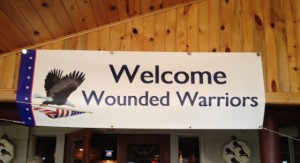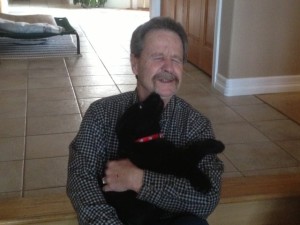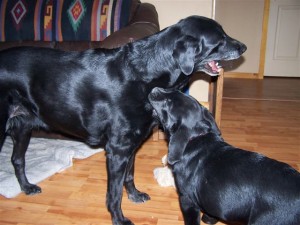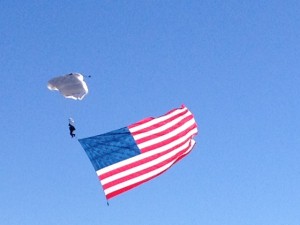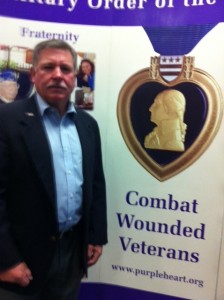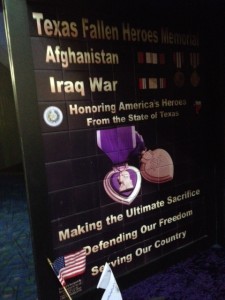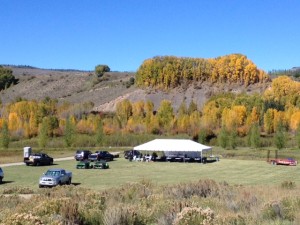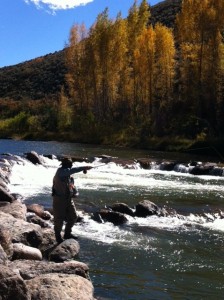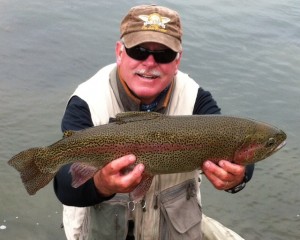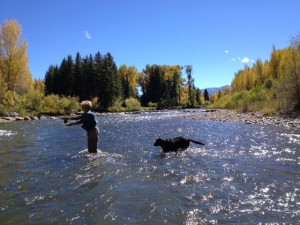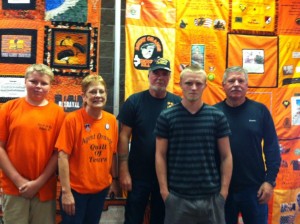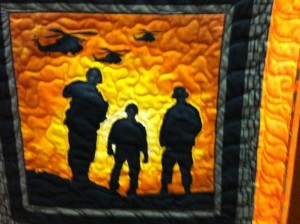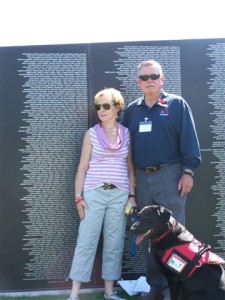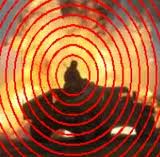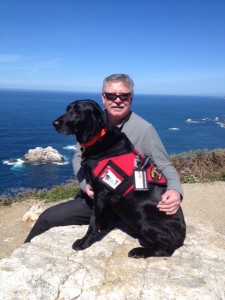Jul
12
Angels on the River
Filed Under Events, Fishing Therapy, Healing Waters, Project Healing Waters, Tears, Tears of a Warrior, Trauma, Wounded Warriors | Comments Off on Angels on the River
by Janet J. Seahorn, Ph.D
It was a bright, warm, late June morning. Platte Valley Trout Unlimited and Project Healing Waters were collectivelyhosting their annual Wounded Warrior Event float trip. The two groups embarked on different sections of the river that Thursday. One group of veterans and their guides launched at Bennett Peak while a second group consisting of veterans from the Cheyenne VA Hospital departed from Treasure Island.
The beauty of the river, the challenge and fun trying to land a big trout, and observing the many creatures such as mink, deer, antelope and eagles made the morning special. Roughly an hour and a half into the float from Treasure Islandtragedy struck. A raft with two couples, who were floating on their own, hit a log jam broadside on a hazardous island point in the middle of the river. As their big raft flipped in the treacherous water, all four individuals went into the swift, cold water…only three were thrown clear of the massive log jam.The fourth rafter did not survive the river’s current even though great effort was made to rescue him from the tremendous force of the water.
Yet, throughout this tragedy there were many angels on the river. Angels that surrounded the rescuers, angels that surrounded the survivors to let them know they were not alone, angels that shuttled the traumatized rafters across the river to waiting medical personnel, angels that kept every veteran and their guides safe. Angels in the form of Army National Guard that found the body downstream and encompassed him in their arms letting the person’s spirit know that he was surrounded with love, respect, and comfort.
Yes, there were numerous angels on the river that morning. Angels, that in spite of the tragedy and sadness, provided many blessings. For you see, in the darkness there was still light, in moments of massive despair, hope arose, and in feelings of being alone there were wings surrounding all who needed strength and comfort.
Jan
22
PUPPY LOVE AND CRAZINESS
Filed Under Dogs, Pets, PTSD, Service Dogs, Tears, Tears of a Warrior, Wounded Warriors | Comments Off on PUPPY LOVE AND CRAZINESS
by Janet J. Seahorn, Ph.D
So you think you want to bring home a new puppy. You know, one of those wiggly, darling, sweet looking bundles of joy. They appear amazing innocent in the entire plethora of internet pictures, advertisements, and billboards. Yep, you definitely believe one of these adorable, four-legged, loveable, furry cherubs known as “man’s best friend” will enhance your life and look great on your next Christmas card. And, you aren’t totally oblivious of what it might take to raise one of these creatures. You’ve had puppies before, of course. You may have been much younger and more patient at the time.
You understand that this energetic whippersnapper will take a pretty good amount of time to potty train, learn new commands, and not bolt at the first slight opening of every door in your home. Hiding any and every item that might go into the puppy’s mouth including expensive eye glasses could end in an inflated doggy hospital visit – sure to cost you an arm and a leg. This will be essential to your pocket book and your endearing, four-legged child’s health. Oh, and did I mention how much puppies love the leather seats of your new truck’s interior.
If your adorable, small creature is going to grow into a huge, muscle bound tank, like my brother’s black lab, Mato, life becomes even more fun to control. Things like not allowing this boiler of energy to greet others, especially children and the elderly, by approaching them like a freight train and jumping full force onto their chests. This will be crucial to avoid unpleasant verbal encounters or even law suits. Of course that once tiny bundle of fur has no clue that he has grown into a ninety pound bruiser of a beast.
Oh, and don’t forget that if you have other household pets, bringing a new four-legged nipper into the pack will require an immense amount of patience, both for you and your other domestic companion. My brother, John, wanted to have another pal for his aging lab, Wyatt. We did something similar with our beloved older lab, Chase, when we brought Hunter Bailey into our abode, and told John, how Bailey helped bring new life back to Chase’s daily routines. It actually, we believed, gave Chase a new lease on life and kept him agile and healthy for several more years. To be honest, Chase did not fully support this perspective. Bailey, however, kept Chase’s competitive spirit active. Chase would not allow his new “buddy” to ever get an edge on any ball, bird, or swimming event.
However, in our limited experience we forgot one significant point. Just like kids, all dogs are not alike, and Mato (Lakota for Bear) was absolutely not like Bailey. Bailey, as the younger dog, was quiet, subservient, and a fairly mild lab compared to when we raised Chase. Chase was more like Mato, impulsive exhaustingly active, and stubborn as hell. My brother’s older dog, Wyatt, has always been a gentle people pleaser, more like Bailey. Poor, innocent Wyatt had no clue what a new puppy would bring to his world.
Today, Wyatt has extreme doggie PTSD from his adopted brother, Mato. Having a huge puppy leaping on him throughout the day, pulling on his ears and legs to induce play, or taking more than one dog’s share of food would be traumatic for any aging canine.
So, what does this story have to do with Post Traumatic Stress of an aging military veteran, one might ask? Bringing a new puppy into your quiet, tranquil home may generate more stress and anxiety than you ever imagined. Just ask my brother, John. He now refers to his beloved puppy, Mato, as a Weapon of Mass Destruction. Need I say more…
Dec
24
YES, MY DEAR VETERAN, THERE IS A SANTA CLAUS
Filed Under American Patriotism, Bless Our Troops, Christmas, Combat PTSD, Dream, Holiday Season, Tears of a Warrior, Tears of Joy | Comments Off on YES, MY DEAR VETERAN, THERE IS A SANTA CLAUS
by Janet J. Seahorn, Ph.D
“Nobody can conceive or imagine all the wonders there are unseen and unseeable in the world.”
Francis P. Church
At this time of year it may be hard for many to believe in much of anything, not to mention a person named Santa Claus. Nevertheless, I still love the story of how the letter, “Yes, Virginia, There is a Santa Claus” came to be. It was written way back in 1897 by a man named Francis Church. Mr. Church was an editor of the Sun newspaper and when receiving a letter from a small girl by the name of Virginia O’Hanlon asking if there was a Santa Claus he wrote his now famous letter. You see, Virginia’s father told her if something appeared in the Sun it must be true. Golly, how times have changed. At any rate, I still find his response to the small Virginia a reminder how important it is to believe in the kinder, sweeter things in life. How miracles surround us every single day, but in our despair we may only be able to see the cruel, bitter, and oftentimes heartbreaking fragments of the moment. Perhaps reading Mr. Church’s famous letter might remind us all of what is really important during this holiday season. His words are as enduring now as they were way back in 1897.
The answer as published in the New York Sun was:
Virginia, your little friends are wrong.
They have been affected by the skepticism of a skeptical age. They do not believe except they see. They think that nothing can be which is not comprehensible by their little minds. All minds, Virginia, whether they be men’s or children’s, are little. In this great universe of ours, man is a mere insect, an ant, in his intellect as compared with the boundless world about him, as measured by the intelligence capable of grasping the whole of truth and knowledge.

Yes, Virginia, there is a Santa Claus. He exists as certainly as love and generosity and devotion exist, and you know that they abound and give to your life its highest beauty and joy. Alas! how dreary would be the world if there were no Santa Claus! It would be as dreary as if there were no Virginias. There would be no childlike faith then, no poetry, no romance to make tolerable this existence. We should have no enjoyment, except in sense and sight. The external light with which childhood fills the world would be extinguished.
Not believe in Santa Claus! You might as well not believe in fairies. You might get your papa to hire men to watch in all the chimneys on Christmas eve to catch Santa Claus, but even if you did not see Santa Claus coming down, what would that prove? Nobody sees Santa Claus, but that is no sign that there is no Santa Claus. The most real things in the world are those that neither children nor men can see. Did you ever see fairies dancing on the lawn? Of course not, but that’s no proof that they are not there. Nobody can conceive or imagine all the wonders there are unseen and unseeable in the world.

You tear apart the baby’s rattle and see what makes the noise inside, but there is a veil covering the unseen world which not the strongest man, nor even the united strength of all the strongest men that ever lived could tear apart. Only faith, poetry, love, romance, can push aside that curtain and view and picture the supernal beauty and glory beyond. Is it all real? Ah, Virginia, in all this world there is nothing else real and abiding.
No Santa Claus! Thank God! he lives and lives forever. A thousand years from now, Virginia, nay 10 times 10,000 years from now, he will continue to make glad the heart of childhood.
If you are finding yourself in the Grinch mode, read Virginia’s letter and think about whatever is good, precious, or beautiful in your life and choose to believe.
Nov
13
SALUTING HEROS
Filed Under American Patriotism, Combat PTSD, Peace, PTSD, Service Dogs, Tears, Tears of a Warrior, Veteran's Day, Wounded Warriors | Comments Off on SALUTING HEROS
by Janet J. Seahorn, Ph.D
If you have never been to Lubbock, Texas it is a flat, dry, and very youngAmericanCity. It was founded in 1911 which was a bit surprising considering that today it is home to around 250 thousand people as well as the well-knownTexasTechUniversity. TTU has the largest campus of any university in the United States and an attendance of close to 35,000 students. There are few places one can go where they don’t see some logo or item related to the Red Raiders. I must admit I really liked their black, red, and gray colors…. a very classy look for their entire plethora of apparel, knick-knacks, jewelry, poster, etc. Texas Tech is also home to the largest Vietnam archives in the world. People from anywhere in the world can access their files through internet with little or no cost.
However, here is what impressed us the most about the university and its personnel, it is a very veteran friendly campus and tries to honor its veterans and their families every day. Last week, before Veteran’s Day, it hosted a four day event celebrating veterans and families. On Wednesday they oversaw their first Veteran’sSummit. It was a day of learning about the challenges of returning from war and transitioning into a community where less than one percent of the population has been fighting the last ten years in Iraq and Afghanistan. Various professionals, including Tony and I, spoke of the difficulties of living with Post Traumatic Stress and Traumatic Brain Injuries. A doctor addressed the complexities of vision problems veterans face. Several veterans, including a panel of four young men who served in Iraq and Afghanistan, shared their experiences in combat and how that impacted their ability to reintegrate back into their families and neighborhoods. Their stories were both heartbreaking and informative. COL David Lewis shared what Lubbock is doing for veterans along with how essential it is for every community to have a Veteran’s Court that deals with those who find themselves involved with actions that landed them in jail or mental health facilities.
Friday evening, the community and university put on a banquet for Purple Heart Recipients and their families. Several Gold Star families (those who have lost loved ones) were part of the event and Medal of Honor Recipient, Doc Ballard fromKansas City, was the Keynote Speaker.
One of the most remarkable parts of the four day events was when almost 500 Purple Heart Recipients were treated to the Texas Tech football game. Before the game began, paratroopers floated into the stadium with Old Glory flying behind them. One of the jumpers was Dana Bowman, a veteran who had lost both legs in a fatal skydiving demonstration in 2001. His courage is a testament to how incredibly resilient our men and women in military are when they are in combat and even more so when they return. As he stated in his speech, “It is not the disability, it is the ability” that matters.
For most Americans who have never had to fight for our precious Freedom few realize – especially our young population – what it is to live without Freedom. We must all guard against complacency and never take for granted the gift that each American has been given because of the service of our military. God Bless our armed forces and our many veterans and their families. Freedom is never free. Let’s support and heal all of our veterans every day of every year, not just honor them one day a year. It is the least we can do.
Oct
6
HEALING WATER – HEALING LIVES
Filed Under American Patriotism, Combat PTSD, Dogs, Fishing Therapy, Healing Waters, Life, Project Healing Waters, Tears of a Warrior, Veterans, War, Wounded Warriors | Comments Off on HEALING WATER – HEALING LIVES
by Janet J. Seahorn, Ph.D
So many questions… most unanswered … fill my mind. Questions such as – What is suffering? Why does it exist in our world? How do we lessen the feelings of hurt, pain, anger, and hopelessness? Very few responses are suitable for any one person, any one situation. Yet, it seems like nature is one of the few healers in our world of chaos and woundedness.
Last week we were privileged to be a part of a Healing Waters activity at the Blue Valley Ranch inKremmling,Colorado. Twenty four vets from FortCarson who are part of the FortCarson’s reintegration program and several who had been former members of the military took part in the program. For four days and nights Project Healing Waters Staff, along with community members and fishing guides volunteered their time and boats to wade fish theBlueRiverand float theColorado. Everyone strived to make the veteran’s activity a nurturing and healing experience.
Long before the adventure began, participants began learning about the art and craft of fly fishing. They learned the various life cycles of flies and many even took up fly tying which has proved to be a very important part of their life-long healing. Once the group arrived at the ranch they were fully equipped with expensive fly rods, fishing vests, hats, and other fly fishing necessities. Each veteran was accompanied by a personal guide to assist, coach, and make sure every need was addressed during the four days on the water. BlueValleyRanch is a good steward of the land and the staff works hard to ensure a high level of commitment to their warrior guests.
But here is the fundamental mission of Project Healing Waters Fly Fishing… it is not to merely provide a few lovely days in beautiful surroundings. The primary mission of Healing Waters is to give each wounded warrior an introduction to an activity and potential life experience that can help heal their mind, body and spirit… It is simply not enough to go away for a few days and fish. Staying in touch with the guides, roommates, or others who have touched their hearts is essential. The guides and Healing Waters partners are around to take the participants on future trips. They are available to talk, to go for coffee or a meal, and to merely be an extended part of their new family.
Yes, Healing Waters most definitely provides comfort and hope to any traumatized individual. However, it is people who heal people. It is communities that offer support and nurturing, and it is being with animals and beautiful surroundings in nature that help a wounded soul believe that even in a harsh world, there is still immense beauty waiting to be experienced.
Quite simply it is the unpretentious comfort of nature and humankind that brings one back to believing in the humanity that is still present even if one can’t immediately see or feel its presence.
So, go to the river to heal, and be sure to include your faithful dog companion to complete the experience.
Aug
11
AGENT ORANGE: “QUILT OF TEARS”
Filed Under Agent Orange, Combat PTSD, Healing, Tears of a Warrior, Trauma, Veterans | Comments Off on AGENT ORANGE: “QUILT OF TEARS”
by Janet J. Seahorn, Ph.D
It was during our work in Hot Springs, SD with the American Legion and the “Honoring Our Heroes” event that we were able to view for the first time the “Quilt of Tears”. This is an unbelievable sea of orange fabrics with hundreds of patches depicting the stories of those Vietnam veterans and families who have suffered with the effects of Agent Orange.
Much of what is in this blog will be taken from a pamphlet I picked up at the quilt display. The quilt is being cared for, assembled, and driven across the United States by Shelia and Henry Snyder (amrdangel@aol.com).
Many veterans and their family members still do not know much about the effects of exposure to Agent Orange. An accurate number of casualties is “almost impossible to record due to various reasons, but the estimated number has been at 250,000 for quite a few years”, and the number grows every day. Even today, few Americans know that Agent Orange was a powerful herbicide used during the Vietnam War to deforest the jungle in order to set up base camps for our troops. Understanding the effects of Agent Orange on an individual is frightening. These powerful chemicals could literally take down a thick canopy of trees in a short few days. Think about, if it could destroy these huge trees in a matter of days — imagine what these chemicals could do to the fragile human body.
Exposure to Agent Orange can be fatal. Some of the diseases which are currently thought to be a result of these herbicides are Chloracne, Hodgkin’s Disease, Multiple Myeloma, Non-Hodgkin’s Lymphoma, Peripheral Neuropath, Porphyria cutanea tarda, Prostate Cancer, Respiratory Cancers, Soft-Tissue Sarcoma, Type II Diabetes, and illnesses and birth defects for the veteran’s children.
It is essential that veterans who have been exposed to Agent Orange get regular physicals complete with CAT Scans to detect the chemicals related to cancers. As with all diseases, early detection is critical to positive long-term outcomes.
The “Quilt of Tears” is a non-profit organization and relies solely on private donations. To learn more go to the website: www.agentorangequiltoftears.com. Individuals can get information on how they can create his or her own personal patch for the quilt at this site.
“Fear not my great soldier…for your story shall be passed down through the years because the fabric of your life is sewn into the Quilt of Tears.”
Jul
28
HEARING LOSS – THE TRULY SILENT WOUND
Filed Under Brain Injury, Combat PTSD, Dogs, Healing, Hearing Loss, Heroes With Hearing Loss, Service Dogs, Tears, Tears of a Warrior | Comments Off on HEARING LOSS – THE TRULY SILENT WOUND
by Janet J. Seahorn, Ph.D
Much of the time we write about the challenges of Post-Traumatic Stress, a silent wound no one can see, yet its effects can consume a person’s mind, heart, spirit, and even soul. However, there is a very physical silent wound that many individuals face, especially veterans who have been in combat zones where IEDs, bomb & RPG blasts and other tragic events cause a physical hearing loss.
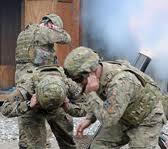 Losing any of our senses makes negotiating the daily routines of life much more difficult. And losing the loss of hearing separates one from the ability to participate in the most common of daily tasks. Simple activities like going to the store and trying to communicate with the checkout person, or straining to understand what your waiter is telling you at a restaurant can be challenging. Consider, also, what it takes to have a conversation on the phone. Most of us take these common everyday tasks for granted. Thanks goodness for new technologies like texting.
Losing any of our senses makes negotiating the daily routines of life much more difficult. And losing the loss of hearing separates one from the ability to participate in the most common of daily tasks. Simple activities like going to the store and trying to communicate with the checkout person, or straining to understand what your waiter is telling you at a restaurant can be challenging. Consider, also, what it takes to have a conversation on the phone. Most of us take these common everyday tasks for granted. Thanks goodness for new technologies like texting.
It was an early Friday morning and I was heading to the airport to catch a flight to Louisville, Kentucky. Tony had accepted an invitation for both of us to speak on several panels regarding hearing loss and combat veterans. In between the acceptance and the trip, he got a special opportunity to spend ten days in Alaska fishing for salmon and halibut. This proved to be an offer he couldn’t refuse. So you guessed it, I was doing this one alone, kind of like Tonto without the Lone Ranger.
Once I arrived in Louisville I had the wonderful privilege of spending several days with four wounded veterans and three of their wives. All of the vets had severe hearing loss from an IED explosion or near a suicide bomber, and one who had contacted an unusual illness that caused him to lose his hearing due to the cartilage in his body being eaten away. Three of the four vets also suffered with pretty severe traumatic brain injuries.
 What was quite amazing about this group was not what they had lost, but how far they had come in addressing their condition and moving forward. And to make this situation even more remarkable was that each had a wife who was incredibly supportive and tenacious on making sure that her husband fought for his recovery as she helped fight for appropriate services in the healing journey. One of the wives had a Master’s degree in Occupational Therapy while another had a background in working with the deaf and was skilled at sign language and other techniques to use when working with individuals faced with hearing loss.
What was quite amazing about this group was not what they had lost, but how far they had come in addressing their condition and moving forward. And to make this situation even more remarkable was that each had a wife who was incredibly supportive and tenacious on making sure that her husband fought for his recovery as she helped fight for appropriate services in the healing journey. One of the wives had a Master’s degree in Occupational Therapy while another had a background in working with the deaf and was skilled at sign language and other techniques to use when working with individuals faced with hearing loss.
What was an Aha Moment for me after being around these couples is the fact that there are “tip” sheets to assist with adjustments to hearing loss.
-Tips like stand still and face the individual with whom you are talking.
-Talk clearly.
-Try to keep to the point and don’t overuse words.
Darn, these were things Tony and I learned the hard way. I could have benefited knowing these years ago. The list reminded me of training our dogs… you do the same things… when giving directions or a command. Stand still. Use minimal words such as stay, sit, down, eat, kennel, etc…Kind of showed us that training ourselves sometimes is very much like training our animal friends.
For any person with a hearing loss and especially our returning veterans and families, get informed about all the new technologies and assist devices that can greatly enhance the ability to function. If you are in this category you will have to be your own fervent advocate. If you aren’t satisfied with your services, keep pushing for any new ideas or programs that are available. Do your Google searches. The Veteran Centers are pretty overwhelmed with the number of veterans needing services, therefore, you will need to be the bull terrier not willing to give up or give in until you are convinced all that can be done, has been done.
Adapted hearing devices are available through many American companies. One such organization is Hamilton CapTel. It produces a caption phone that has been a Godsend to Tony. Hamilton CapTel has just launched a new program called Heroes with Hearing Loss www.heroeswithhearingloss.com The program focuses on education and information for navigating the world of the hard of hearing. Take a look at their video. You may even want to “Like” them on Facebook to get more information.
http://www.multivu.com/mnr/62613-heroes-with-hearing-loss-new-program-debuts-vfw-national-convention
In the end I am reminded of a quote by Joseph Fort Newton. It clearly captures the essence of so many of our military personnel and their families who continue to wake up every day and courageously move forward toward their personal healing and their mission of making a difference for others.
“We cannot tell what may happen to us in the strange medley of life. But we can decide what happens in us, how we take it, what we do with it —– and that is what really counts in the end.”
Jul
12
CHASE’S MEADOW
Filed Under Aging, Dogs, Family, Fishing Therapy, Healing Waters, Journey, Life, Love, Peace, Pets, PTSD, Service Dogs, Tears of a Warrior, Tears of Joy, Veterans | Comments Off on CHASE’S MEADOW
by Tony & Janet Seahorn
The human heart and mind are amazing in their capacity to experience intense sadness and abundant gratitude at the same time. That lump in the throat is still there as are the tears that cloud my eyes. Yet, the weight of the death of our wonderful Chase seems to be a bit lighter.
Earlier this week, we visited Chase’s most beloved mountain meadow, high on the Snowy Range in southern Wyoming. It is a beautiful, alpine meadow filled with wild flowers and a running brook. This is the place we chose to spread his ashes and place a stone memorial on a wooded ridge overlooking the peaceful valley below.
We promised to make this journey after the early summer snow melt and before the wildflowers were in full bloom.
His very essence now glides in the winds and rolls gently with the flowing water. White and yellow flowers line his final path. He is at peace, as are we. And younger brother Bailey still romps through the brightly colored grasses chasing after his cherished tennis ball – a reminder that joy is always present around and within our souls.
As we paid our final respects it seemed as if Chase was giving us his final message:
I am now in my meadow; my ashes white as angels’ wings float with the Wind and flow through the mountain streams to places I never ran in life.
Peace and beauty will always surround me with a green and white and purple blanket of sweet columbines.
This is where I was finally meant to be.
Therefore, honor me not with tears of sadness, but with hearts of joyfulness.
Remember me with stories and laughter.
And most of all know that as much as you loved me I loved you even more.
Black Forest Chase
April 23, 1999 – January 4, 2013
Jun
25
FIELD OF HONOR
Filed Under Field of Honor, Flag Day, PTSD, Tears of a Warrior, Veterans, Wounded Warriors | Comments Off on FIELD OF HONOR
by Janet J. Seahorn, Ph.D
One thousand, full sized, American flags flew on a grassy green, long rolling boulevard in Cody, Wyoming.
It was their second annual Field of Honor Flag Day. Each flag was purchased on someone’s behalf. Sometimes it was for a family member who had served in the military. Some flags were given in honor of a special friend. And some were purchased to show respect and gratitude to an organization or group who has made a difference in their community. At any rate, up until this event, I have never seen so many large flags jam-packed in one place. Quite an impressive sight for these timeworn eyes.
This vista reminded me of a saying by Sara Teasdale, “My soul is a broken field, plowed by pain”. This field was created to honor those who sacrificed so much for their country, their communities, and their fellow Americans. Each flag was a tangible reminder of the broken souls, bodies, and hearts impacted by wars old and new. We brought two flags, one to commemorate an uncle who I had never met who died in WWII as part of Patton’s assault in Normandy; the other was to pay tribute to Tony and all those who served in Vietnam.
What made this a wonderful event were the charming individuals who attended the four days of celebrations. Much like the Vietnam Wall experience, many visited the Field of Honor to pay their respect, to view the sight of these amazing flags sometimes pounded ruthlessly by the heavy winds of Wyoming. There were times when some of us wondered if they would sustain such severe gusts. Yet, they did, every day, every night, and every gale. Several of the individuals we met were like the flags, tough, reliable, and persistent.
One veteran, John, was a ninety year old man who served in WWII in Africa, then Korea, and finally Vietnam. After our presentation he stated he would once again be visited by nightmares and visions from his past war conflicts. “They never seem to go away”, he declared, “and continually find their way into my thoughts and dreams.” The second individual, I watched from our position as guest speakers. He was a young man bouncing around a very small baby who couldn’t be more than a month old. After placing his tiny package into a near-by stroller, he just stood there, listening and watching. Shortly after our talk, I walked over to where he was standing and asked if he was a veteran. “Yes”, he responded. He had served several tours in combat. Much like the stories I told of a few of my university students who tried to return to school after war, he also dropped out, unable to withstand the innocence of a campus youth who have never been exposed to war’s trauma. Now he was in the process of reorganizing his life as a new father/husband, and finding a fulfilling purpose for his life. A life that he will have to fight for in order to live fully. A life with struggles. Much like his combat encounters, he will have to accept and move forward. A life with some sorrows that must be endured. And a life created with his special song that must be sung with great passion.
So here is wishing peace to all the John’s that went through too many battles and still struggle with their demons after such a very long time. And for all the young Patrick’s who are composing their own unique melodies.
May their ballads be full of love, laughter, and happiness.
May
29
NOT FORGOTTEN
Filed Under Healing, Memorial Day, Tears of a Warrior, Veterans Plaza, Vietnam Veterans, War, Wounded Warriors | Comments Off on NOT FORGOTTEN
by Janet J. Seahorn, Ph.D
It has been a really long Memorial Day Week and we are truly exhausted.
For the last six days we have been privileged to be a part of bringing the large version (80%) Traveling Vietnam Wall to Fort Collins,Colorado. The city of Fort Collins put in its request back in 2003 to host this special event over Memorial Day Weekend. With extensive planning throughout the last six months, the Veterans Plaza Committee of Northern Colorado wondered how many people might visit the Wall and pay homage to all who made the ultimate sacrifice in service to their country.
Our answer came and all were humbled.
Thousands came daily. They came to pay their respects. They came to pray. And some came to simply heal a bit more. Seeing the names of classmates and friends lost in battle is sad indeed, but viewing the names of fallen comrades with whom you served is far more profound.
I watched as young children were educated about how all those names got on the structure. One small child innocently asked, “You mean they are all dead?” For this tiny boy it was hard to comprehend such a large number. For those who served it was even harder to comprehend and accept once again the huge price of war.
The Vietnam Wall is more than a memorial. It is a reminder to our nation of what we did wrong in welcoming our young men and women back after serving overseas. That lesson, I believe has been learned. However, there is so much further we need to grow. As our military returns from war, as a nation we need to make sure that they are comforted, healed, and given work that will allow them to have a solid future. And we need to make sure we are more aware of those veterans and families who have endured a great deal in the name of freedom. They are the silent minority and too many are finding it gut-wrenching hard to reintegrate back into their communities.
After observing the thousands of individuals who visited the Traveling Vietnam Wall these last many days, I truly believe we, as a community/nation, have the will to accomplish this task of human restoration.
What is hard, is taking the time during our very busy days to notice what needs to be done and then do it. Each small step we take moves all of us closer to a healthier and more humane nation.
God does truly bless America when we take the time to meet the needs of others.




